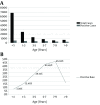Th1/Th2 Cytokine Profile and Its Diagnostic Value in Mycoplasma pneumoniae Pneumonia
- PMID: 26848377
- PMCID: PMC4733293
- DOI: 10.5812/ijp.3807
Th1/Th2 Cytokine Profile and Its Diagnostic Value in Mycoplasma pneumoniae Pneumonia
Abstract
Background: The levels of Th1/Th2 cytokine can alter in pathogenic infection in children with pneumonia.
Objectives: To evaluate Th1/Th2 cytokine profile and its diagnostic value in M. pneumoniae pneumonia in children.
Patients and methods: Children with M. pneumoniae mono-infection and 30 healthy children were tested with cytokines assay. We used real time PCR to detect M. pneumoniae in children with pneumonia.
Results: M. pneumoniae test was positive in 2188 (16.62%) out of 13161 pneumonia children. Children aged 5 - 9 years had the highest rate and summer was a season with high rate of M. pneumoniae incidence in Zhejiang province. During the course of study, in 526 pneumonia children with M. pneumoniae mono-infection and 30 healthy children cytokines assay was performed. IL-2 level of M. pneumoniae pneumonia children was lower than that of healthy children (median levels, pg/mL: IL-2: 3.2 vs. 5.7, P = 0.00), while IL-4, IL-10 and IFN-γ were higher than in healthy children (median levels, pg/mL: IL-4: 3.2 vs. 1.5, P = 0.00; IL-10: 5.6 vs. 2.5, P = 0.001; IFN-γ: 20.4 vs. 4.8, P = 0.001).
Conclusions: IL-2 decreases and IL-4, IL-10 and IFN-γ increase in children with M. pneumoniae pneumonia, which has a promising prospect in diagnosis of this disease in clinical practice.
Keywords: Children; Cytokines; M. pneumoniae; Pneumonia.
Figures
Similar articles
-
Relationships between Th1/Th2 cytokine profiles and chest radiographic manifestations in childhood Mycoplasma pneumoniae pneumonia.Ther Clin Risk Manag. 2016 Nov 11;12:1683-1692. doi: 10.2147/TCRM.S121928. eCollection 2016. Ther Clin Risk Manag. 2016. PMID: 27956836 Free PMC article.
-
Role of interleukin-18 and T-helper type 1 cytokines in the development of Mycoplasma pneumoniae pneumonia in adults.Chest. 2002 May;121(5):1493-7. doi: 10.1378/chest.121.5.1493. Chest. 2002. PMID: 12006434
-
Serum cytokine profile contributes to discriminating M. pneumoniae pneumonia in children.Cytokine. 2016 Oct;86:73-78. doi: 10.1016/j.cyto.2016.07.018. Epub 2016 Jul 29. Cytokine. 2016. PMID: 27475111
-
Levels of interleukin-2, interferon-gamma, and interleukin-4 in bronchoalveolar lavage fluid from patients with Mycoplasma pneumonia: implication of tendency toward increased immunoglobulin E production.Pediatrics. 2001 Mar;107(3):E39. doi: 10.1542/peds.107.3.e39. Pediatrics. 2001. PMID: 11230620
-
Cytokine secretion in children with acute Mycoplasma pneumoniae infection and wheeze.Pediatr Pulmonol. 2002 Aug;34(2):122-7. doi: 10.1002/ppul.10139. Pediatr Pulmonol. 2002. PMID: 12112778
Cited by
-
Impact of atopy on the severity and extrapulmonary manifestations of childhood Mycoplasma pneumoniae pneumonia.J Clin Lab Anal. 2019 Jun;33(5):e22887. doi: 10.1002/jcla.22887. Epub 2019 Mar 29. J Clin Lab Anal. 2019. PMID: 30924557 Free PMC article.
-
Azithromycin sequential therapy plus inhaled terbutaline for Mycoplasma Pneumoniae pneumonia in children: a systematic review and meta-analysis.BMC Infect Dis. 2024 Jun 28;24(1):653. doi: 10.1186/s12879-024-09564-x. BMC Infect Dis. 2024. PMID: 38944667 Free PMC article.
-
Anti-inflammatory effects of Boletus edulis polysaccharide on asthma pathology.Am J Transl Res. 2016 Oct 15;8(10):4478-4489. eCollection 2016. Am J Transl Res. 2016. PMID: 27830033 Free PMC article.
-
Relationships between Th1/Th2 cytokine profiles and chest radiographic manifestations in childhood Mycoplasma pneumoniae pneumonia.Ther Clin Risk Manag. 2016 Nov 11;12:1683-1692. doi: 10.2147/TCRM.S121928. eCollection 2016. Ther Clin Risk Manag. 2016. PMID: 27956836 Free PMC article.
-
Evaluation of a real-time method of simultaneous amplification and testing in diagnosis of Mycoplasma pneumoniae infection in children with pneumonia.PLoS One. 2017 May 16;12(5):e0177842. doi: 10.1371/journal.pone.0177842. eCollection 2017. PLoS One. 2017. PMID: 28520818 Free PMC article.
References
-
- Gotoh K, Nishimura N, Takeuchi S, Hattori F, Horiba K, Isaji M, et al. Assessment of the loop-mediated isothermal amplification assay for rapid diagnosis of Mycoplasma pneumoniae in pediatric community-acquired pneumonia. Jpn J Infect Dis. 2013;66(6):539–42. - PubMed
Grants and funding
LinkOut - more resources
Full Text Sources
Other Literature Sources


